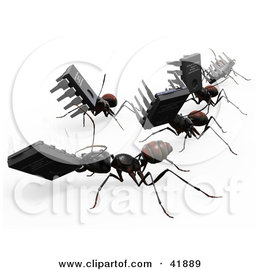
The way ants behave when their colony is under threat is the inspiration behind a new generation of network security software, which has been successfully deployed by security experts:
http://www.business-standard.com/india/news/digital-ants-torescue/371377/ By mimicking the behaviour of real ants, security experts hope this method will defeat computer worms faster than conventional security software.
Glenn Fink, a research scientist at Pacific Northwest National Laboratory in Richland, Washington, came up with the idea. In the natural world ants wander about randomly, returning to the colony when they find a threat or food. On the way back, they leave a trail of pheromones. As other ants find the trail, they follow it and reinforce it. Likewise, these "digital ants" will wander through computer networks looking for threats. When a threat is found, many ants will arrive at the scene, grabbing the attention of a human operator who will investigate further.
"Our idea is to deploy 3,000 different types of digital ants, each looking for evidence of a threat," said Wake Forest Professor of Computer Science, Errin Fulp. "As they move about the network, they leave digital trails modelled after the scent trails ants in nature use to guide other ants. Each time a digital ant identifies some evidence, it is programmed to leave behind a stronger scent. Stronger scent trails attract more ants, producing the swarm that marks a potential computer infection."
An application of "Swarming Intelligence" - examples of which can be observed in ant colonies, bird flocking and animal herding - the digital ants should result in faster detection of network security threats without the need for regular virus definition updates:
http://en.wikipedia.org/wiki/Swarm_intelligenceYou need not worry about a swarm of digital ants infesting your computer either - the digital ants require software "sentinels" located at each computer within the network, which in turn report to human-monitored network "sergeants", ensuring humans maintain control of the colony.
(NeoWin)




 Total Members: 14197
Total Members: 14197







